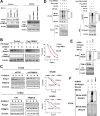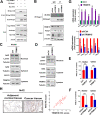E3 ligase TRIM15 facilitates non-small cell lung cancer progression through mediating Keap1-Nrf2 signaling pathway
- PMID: 35534896
- PMCID: PMC9082862
- DOI: 10.1186/s12964-022-00875-7
E3 ligase TRIM15 facilitates non-small cell lung cancer progression through mediating Keap1-Nrf2 signaling pathway
Abstract
Background: Recent studies have indicated that some members of the tripartite motif (TRIM) proteins function as important regulators for non-small cell lung cancer (NSCLC), However, the regulatory mechanism underpinning aberrant expression of TRIM in NSCLC remains unclear. Here we report that TRIM15 plays important roles in NSCLC progression through modulating Keap1-Nrf2 signaling pathway.
Methods: TRIM15 expression was evaluated by western blot analysis, tissue microarray-based immunohistochemistry analysis. The interactions between TRIM15 and Keap1 were analyzed by co-immunoprecipitation (Co-IP) and immunofluorescence co-localization assay. The correlation between TRIM15 and Keap1 was measured by Co-IP and ubiquitination analysis in vitro. Gain- and lost-of-function experiments were used to detect TRIM15 promotes proliferation and invasion of NSCLC cells both in vitro and vivo.
Results: Here, we revealed that TRIM15 was frequently upregulated in NSCLC samples and associated with poor prognosis. Functionally, TRIM15 knockdown resulted in decreased cancer cell proliferation and metastasis, whereas ectopic TRIM15 expression facilitated tumor cancer cell proliferation and metastasis in vitro and in vivo. Moreover, TRIM15 promoted cell proliferation and metastasis depends on its E3 ubiquitin ligase. Mechanistically, TRIM15 directly targeted Keap1 by ubiquitination and degradation, the principal regulator of Nrf2 degradation, leading to Nrf2 escaping from Keap1-mediated degradation, subsequently promoting antioxidant response and tumor progression.
Conclusions: Therefore, our study characterizes the pivotal roles of TRIM15 promotes NSCLC progression via Nrf2 stability mediated by promoting Keap1 ubiquitination and degradation and could be a valuable prognostic biomarker and a potential therapeutic target in NSCLC. Video Abstract.
Keywords: Keap1; NSCLC; Nrf2; TRIM15; Ubiquitination and degradation.
© 2022. The Author(s).
Conflict of interest statement
The authors declare that they have no competing interests.
Figures







Similar articles
-
Keap1-Nrf2 Interaction Suppresses Cell Motility in Lung Adenocarcinomas by Targeting the S100P Protein.Clin Cancer Res. 2015 Oct 15;21(20):4719-32. doi: 10.1158/1078-0432.CCR-14-2880. Epub 2015 Jun 15. Clin Cancer Res. 2015. PMID: 26078391
-
PIDD interaction with KEAP1 as a new mutation-independent mechanism to promote NRF2 stabilization and chemoresistance in NSCLC.Sci Rep. 2019 Aug 27;9(1):12437. doi: 10.1038/s41598-019-48763-4. Sci Rep. 2019. PMID: 31455821 Free PMC article.
-
TRIM13 inhibits cell proliferation and induces autophagy in lung adenocarcinoma by regulating KEAP1/NRF2 pathway.Cell Cycle. 2023 Jun;22(12):1496-1513. doi: 10.1080/15384101.2023.2216504. Epub 2023 May 28. Cell Cycle. 2023. PMID: 37245083 Free PMC article.
-
The Molecular Mechanisms Regulating the KEAP1-NRF2 Pathway.Mol Cell Biol. 2020 Jun 15;40(13):e00099-20. doi: 10.1128/MCB.00099-20. Print 2020 Jun 15. Mol Cell Biol. 2020. PMID: 32284348 Free PMC article. Review.
-
Molecular mechanisms of the Keap1–Nrf2 pathway in stress response and cancer evolution.Genes Cells. 2011 Feb;16(2):123-40. doi: 10.1111/j.1365-2443.2010.01473.x. Genes Cells. 2011. PMID: 21251164 Review.
Cited by
-
Ubiquitin-proteasome system as a target for anticancer treatment-an update.Arch Pharm Res. 2023 Jul;46(7):573-597. doi: 10.1007/s12272-023-01455-0. Epub 2023 Aug 5. Arch Pharm Res. 2023. PMID: 37541992 Review.
-
TRIM family contribute to tumorigenesis, cancer development, and drug resistance.Exp Hematol Oncol. 2022 Oct 19;11(1):75. doi: 10.1186/s40164-022-00322-w. Exp Hematol Oncol. 2022. PMID: 36261847 Free PMC article. Review.
-
Integrated immunogenomic analysis of single-cell and bulk profiling reveals novel tumor antigens and subtype-specific therapeutic agents in lung adenocarcinoma.Comput Struct Biotechnol J. 2024 Apr 24;23:1897-1911. doi: 10.1016/j.csbj.2024.04.056. eCollection 2024 Dec. Comput Struct Biotechnol J. 2024. PMID: 38721587 Free PMC article.
-
Polyphenols alleviate metabolic disorders: the role of ubiquitin-proteasome system.Front Nutr. 2024 Aug 12;11:1445080. doi: 10.3389/fnut.2024.1445080. eCollection 2024. Front Nutr. 2024. PMID: 39188976 Free PMC article. Review.
-
Ubiquitination regulates autophagy in cancer: simple modifications, promising targets.J Transl Med. 2024 Oct 31;22(1):985. doi: 10.1186/s12967-024-05565-1. J Transl Med. 2024. PMID: 39482684 Free PMC article. Review.
References
Publication types
MeSH terms
Substances
LinkOut - more resources
Full Text Sources
Medical
Molecular Biology Databases

